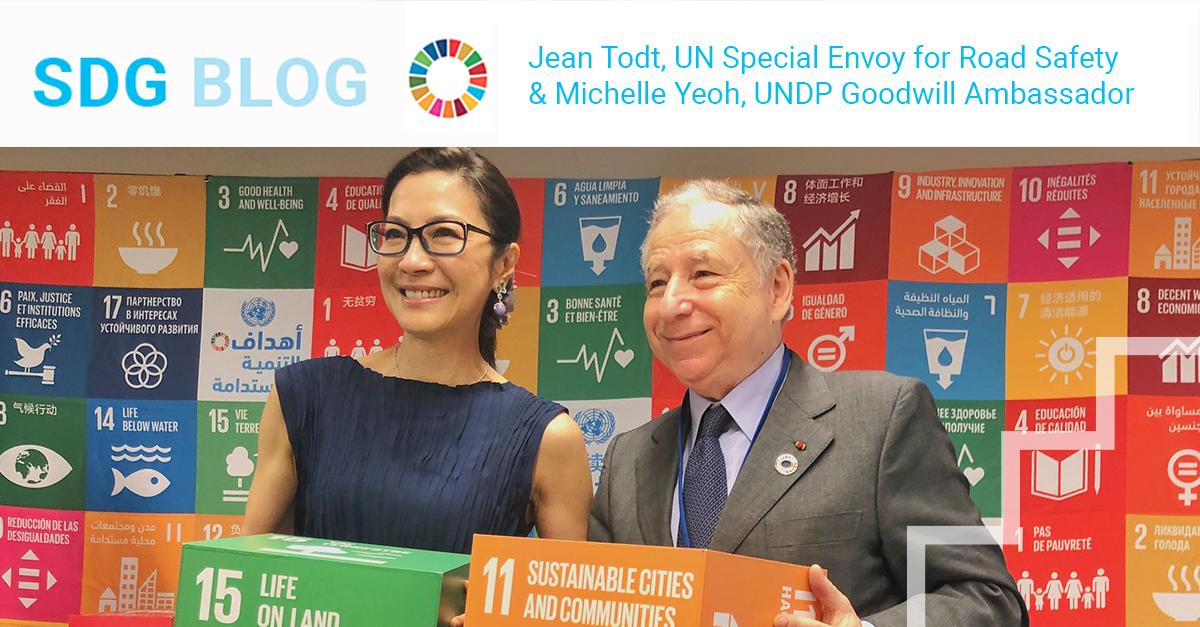SDG Blog

Moving the world in the right direction
By Jean Todt, UN Secretary-General’s Special Envoy for Road Safety and Michelle Yeoh, UNDP Goodwill Ambassador and Actor share their aspirations for achieving sustainable transport globally
With the second United Nations Sustainable Transport Conference taking place in Beijing this month, we, as partners in life and mission, want to share our thoughts on sustainable transport’s critical role in driving sustainable development, climate action and road safety.
Join us on a journey across six areas of transport that are essential to move the world in the right direction.
Combining sustainability and safety
Jean Todt: I believe that sustainability and safety are the two most important issues facing transportation globally; and fortunately, they contribute to each other. For example, with greater inspection and regulations on second-hand cars exported to Africa, we can ensure vehicles meet the minimum safety and environment standards. Another example are the roads themselves, managing the mixed traffic/mixed speed road environments, enabling swift communications systems following accidents and aligning road signs. Not only do these solutions improve road safety, but they also reduce global greenhouse gas emissions, air pollution and congestion. If we set the right policies and build the right infrastructure, we can move quicker, safer and greener.
Solving the inequalities of mobility
Michelle Yeoh: As the UN Development Programme Goodwill Ambassador, and someone from Asia, a region that faces many of these problems, and also as a woman, this resonates deeply with me. More than 90 per cent of the 1.35 million people who die annually in traffic crashes are in low- and middle-income countries, even though these countries have only around 60 per cent of the world’s vehicles. In fact, while many parts of the world reap the benefits of great progress in road safety, fatalities in developing countries continue to rise. Road crashes are the leading killer of young people between the ages of 5 - 29. Each day, some 500 children die in road-related crashes, many as they simply go to school! But the inequalities are everywhere. Studies have shown that women feel more insecure and unsafe taking public transport. We need to work together to address these problems.
More financing to bring bigger returns
Jean Todt: I completely agree with you, Michelle, and not least of the problems in those countries involves financing. Whenever we speak of infrastructure, education and changing people’s habits, we are also speaking of financing. Throughout my career in motorsport, I have been closely involved in both extensive and efficient financing. And I think that the reason why financing road safety and sustainability has faltered in the past is the failure to bring – or to demonstrate – a return on investment. However, we know that safety and sustainability do improve the prosperity and well-being of people across the board. Clean, safe cars driving on ordered, safe and congestion-free highways reduce both pollution and crashes that impose costs on a country’s health system and workforce.
Safe and sustainable transport systems are important for all the SDGs
Michelle Yeoh: This is absolutely correct. We must invest in sustainable transport because it will pay off across all of the Sustainable Development Goals. Despite increasing efforts in recent years, the SDG target to stabilize and then halve road fatalities and injuries by 2020 was not met. Even worse, the world is not on track to meet the road safety targets even by 2030. In fact, road crashes jeopardize the whole sustainable development agenda, and as Jean said, they hurt developing countries economically, preventing vital investment in education, hospitals, access to water and sanitation, climate action and many other areas. Furthermore, well over half of the 17 SDGs can be served through a safe and sustainable mobility. For example, Goal 11: Sustainable Cities and Communities; Goal 13: Climate action, Goal 15: Life on land, etc.
The UN Road Safety Fund, the upcoming High-Level Meeting on Road Safety in July 2022, and the Global Plan for the Decade of Action for Road Safety (2021-2030)
Jean Todt: Indeed Michelle. In 2018, I helped to create the UN Road Safety Fund as the first specific funding instrument of the United Nations for global road safety programmes. Each $100 million generated by the fund could support the leveraging of $3.4 billion of country and city road safety investment to save 64,000 lives and prevent 640,000 serious injuries. We need to create such instruments to achieve sustainable transport directly with dedicated systems. This Beijing conference, in fact, is a good time to prepare for the High-level meeting on Road Safety in New York in July 2022, which will bring together officials of public and private sector to commit to our Global Plan for the Decade of Action for Road Safety (to be launched on 28 October) and ensure that this time around we do meet our road safety related SDG targets.
The benefit of thinking outside of the box
Michelle Yeoh: As an actress, I am often faced with huge personal challenges about how a character should react in a certain situation. Sometimes, that calls for thinking way outside of the box. The same is necessary when thinking about sustainable transport and road safety. Clearly, we need new solutions as the challenges grow. For instance, some of the work being done in Smart Cities initiatives where private industry is challenged to come up with innovative ways to create a better environment. In short, achieving sustainable transport must be the collective responsibility of all the actors and requires a big shift in transport solutions and mindsets.
* The views expressed in this blog are the author’s and do not necessarily reflect the opinion of UN DESA.
 Welcome to the United Nations
Welcome to the United Nations